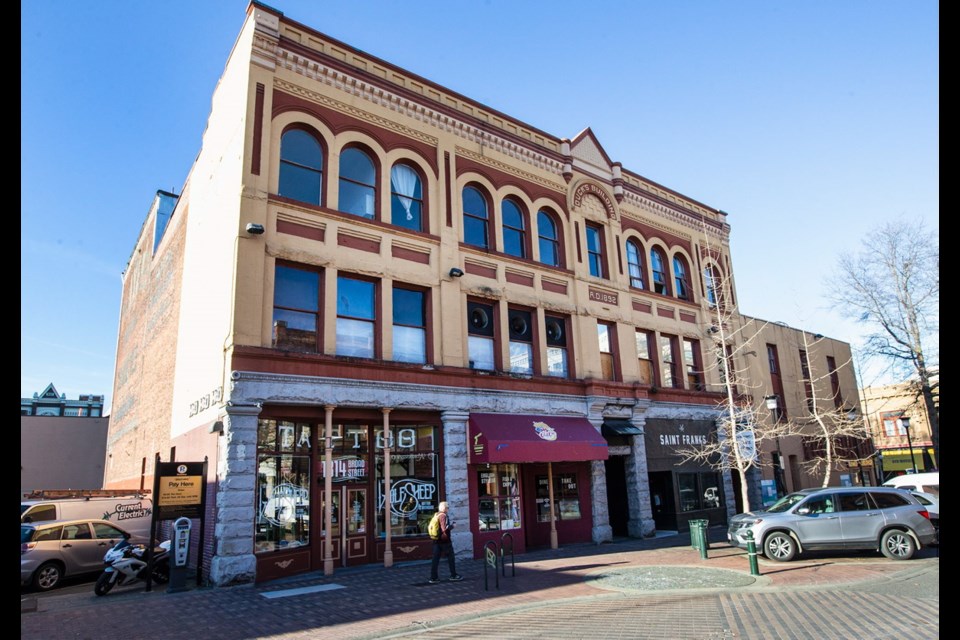A controversial plan to knock down all but three walls of two late 19th-century buildings in downtown Victoria has divided the city’s heritage community.
Heritage advocates and developers are lining up on both sides of the debate over the future of the Duck’s Building and the adjacent Duck’s Carriage Factory, also known as the sa国际传媒 Hotel, at Broad and Johnson streets.
The properties are among those bequeathed to the University of Victoria by Michael Williams, and people on both sides in the debate claim to know how the late developer would have viewed the proposal.
UVic Properties and Chard Development want to use the site to build a 139-room hotel covering nearly a full block of Broad Street. Their proposal preserves the front and rear walls of the 127-year-old Duck’s building and an original rock wall of the Carriage Factory, which dates to 1874.
David Chard, of Chard Development, has said the new building code makes it difficult to preserve the entire Duck’s Building and still ensure its occupants’ safety in the event of a major earthquake.
As for the Carriage Factory, the developer said it has been subject to unsympathetic upgrades over the years and that little of heritage value remains beyond the rubble wall.
The proposal earned the approval of the city’s heritage advisory panel. But its chairwoman, Pamela Madoff, was absent that day and she is firmly opposed to the project.
The former city councillor and long-time heritage advocate said knocking down all but a rubble wall of the Carriage Factory would mark the first time a registered heritage building has been demolished in Old Town since the Eaton Centre development in the 1980s.
She also disputed claims that the factory is too far gone to be restored and rehabilitated, noting in a letter to council that other buildings in a similar state have been successfully restored and given new life.
Chris Le Fevre, who has been restoring heritage buildings in Old Town for decades, agrees. He said the building-code changes don’t justify a shift to protecting only the façades of the city’s heritage buildings — a practice some refer to as “façadism.”
“Yes, the seismic code is changing and it makes for a more difficult economic equation, there’s no question about it,” he said. “But should that give rise to façadism? I don’t believe so.”
Le Fevre, whose company restored the Morley Soda building, Waddington Alley and the Oriental Hotel, among others, said he would take a different approach to the Duck’s Building — one that preserved more of the original structure.
“I would not look at a radical demolition of all but the façade,” he said. “In other words, some major building retention.”
As for the seismic challenges, Le Fevre said: “Anything is possible — it’s a question of whether the economics are tolerable. And if they’re not tolerable to one person, that doesn’t mean they’re not tolerable to another person.
“More particularly, knowing the ins and outs of heritage buildings, and the work that takes, some are more skilled than others.”
Le Fevre said all of his restorations have required reinforcements to walls, roofs, floors and, in some cases, new foundations.
“If a heritage building is not collapsing, why should one knock a heritage building down?” he asked, noting that if the economic conditions aren’t conducive to restoring a building now, those conditions could change in the future.
“If it’s not today, it could be tomorrow.”
He pointed out that the Duck’s buildings were gifts to the university.
“The University of Victoria does not have an acquisition cost and, accordingly, this would make one’s ability to refurbish the building so much easier economically,” he said. “I’m not so sure Mr. Williams, who never demolished a heritage building, would wish to see something he gifted fall in that manner.”
Richard Holmes, who also has a track record of restoring heritage buildings in Victoria, lines up on the other side of the debate. He has submitted a letter to the city in support of Chard’s proposal, arguing that each attempt at heritage restoration needs to be viewed on its own merits.
“There is no doubt that the important element of the Duck’s building is its masterpiece of a musical façade,” he writes. “Its interior, however, lends little to the magic of heritage.”
As for the carriage factory, Holmes echoes Chard in stating that the building has been “so badly changed over the decades [as] to leave little of heritage value.”
Holmes is known for his work restoring heritage structures that include the Temple Building, the Pemberton Holmes Building and a Francis Rattenbury-designed building at Langley and Broughton Streets.
He argues that it’s “trite” to dismiss the Duck’s proposal as “façadism” and notes there are many great examples in the city where façades and other heritage elements were preserved alongside “up-to-code, well-laid-out interiors.”
“One exceptionally successful example of this is our own city hall,” he writes. “If city hall had been obliged to maintain its original interior, the building would have never been able to continue its use as our centre of municipal government and likely would have disappeared by now.”
Holmes adds that he knew Williams, discussed Broad Street with him and is “confident that this proposal would have met with his vision and approval.”



